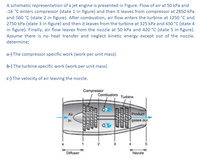
Elements Of Electromagnetics
7th Edition
ISBN: 9780190698614
Author: Sadiku, Matthew N. O.
Publisher: Oxford University Press
expand_more
expand_more
format_list_bulleted
Question

Transcribed Image Text:A schematic representation of a jet engine is presented in Figure. Flow of air at 50 kPa and
-16 °C enters compressor (state 1 in figure) and then it leaves from compressor at 2850 kPa
and 560 °C (state 2 in figure). After combustion, air flow enters the turbine at 1250 °C and
2750 kPa (state 3 in figure) and then it leaves from the turbine at 325 kPa and 650 °C (state 4
in figure). Finally, air flow leaves from the nozzle at 50 kPa and 420 °C (state 5 in figure).
Assume there is no heat transfer and neglect kinetic energy except out of the nozzle.
determine;
a-) The compressor specific work (work per unit mass)
b-) The turbine specific work (work per unit mass)
c-) The velocity of air leaving the nozzle.
Compressor
Combustors
Turbine
Air
Product
in
gases out
a
2
3
4
Diffuser
Nozzle
Expert Solution
This question has been solved!
Explore an expertly crafted, step-by-step solution for a thorough understanding of key concepts.
This is a popular solution
Trending nowThis is a popular solution!
Step by stepSolved in 3 steps

Knowledge Booster
Learn more about
Need a deep-dive on the concept behind this application? Look no further. Learn more about this topic, mechanical-engineering and related others by exploring similar questions and additional content below.Similar questions
- 2. Electrical components often failure due to thermal overload. It follows that thermal analysis of electrical components is critical to their longevity. Consider a silicon chip which is sitting atop a ceramic substrate with 35 mm2 of exposed surface area. Operating at steady state, the chip can pull up to 120 mW of power. The chip surface is cooled by convection from flowing air at 20°C. The heat transfer from the chip to the air is given by Q = hA(T, – T) where h is the thermal convection coefficient, A is the exposed surface area, and Tb and Tr are absolute temperatures of the body and coolant fluid, respectively. h of the flowing air is found to be 250 W/(m2-K). Assuming heat transfer to the substrate is negligible compared to convection, determine: the heat transfer occurring at steady state (W) the temperature at the outer surface of the chip ("C) a. b.arrow_forwardThis question requires the use of the extracts from the tables of thermodynamic properties supplied. Ammonia, NH3, was once a commonly used refrigerant. In a particular (very old) refrigeration plant, ammonia has a pressure of 2.9 bar and a temperature of 40 °C. What would be the specific enthalpy of the ammonia under these conditions. 1433 kJ/kg a. b. 1552 kJ/kg 135 kJ/kg O d. 1622 kJ/kg O e. 1665 kJ/kgarrow_forwardFor a closed system undergoing a thermodynamic cycle, what statement from the list below is correct when comparing the system's initial and final states? Temperature may change. O Pressure may change Volume may change Mass may change Internal energy may change Potential energy may change No system property may changearrow_forward
Recommended textbooks for you
 Elements Of ElectromagneticsMechanical EngineeringISBN:9780190698614Author:Sadiku, Matthew N. O.Publisher:Oxford University Press
Elements Of ElectromagneticsMechanical EngineeringISBN:9780190698614Author:Sadiku, Matthew N. O.Publisher:Oxford University Press Mechanics of Materials (10th Edition)Mechanical EngineeringISBN:9780134319650Author:Russell C. HibbelerPublisher:PEARSON
Mechanics of Materials (10th Edition)Mechanical EngineeringISBN:9780134319650Author:Russell C. HibbelerPublisher:PEARSON Thermodynamics: An Engineering ApproachMechanical EngineeringISBN:9781259822674Author:Yunus A. Cengel Dr., Michael A. BolesPublisher:McGraw-Hill Education
Thermodynamics: An Engineering ApproachMechanical EngineeringISBN:9781259822674Author:Yunus A. Cengel Dr., Michael A. BolesPublisher:McGraw-Hill Education Control Systems EngineeringMechanical EngineeringISBN:9781118170519Author:Norman S. NisePublisher:WILEY
Control Systems EngineeringMechanical EngineeringISBN:9781118170519Author:Norman S. NisePublisher:WILEY Mechanics of Materials (MindTap Course List)Mechanical EngineeringISBN:9781337093347Author:Barry J. Goodno, James M. GerePublisher:Cengage Learning
Mechanics of Materials (MindTap Course List)Mechanical EngineeringISBN:9781337093347Author:Barry J. Goodno, James M. GerePublisher:Cengage Learning Engineering Mechanics: StaticsMechanical EngineeringISBN:9781118807330Author:James L. Meriam, L. G. Kraige, J. N. BoltonPublisher:WILEY
Engineering Mechanics: StaticsMechanical EngineeringISBN:9781118807330Author:James L. Meriam, L. G. Kraige, J. N. BoltonPublisher:WILEY

Elements Of Electromagnetics
Mechanical Engineering
ISBN:9780190698614
Author:Sadiku, Matthew N. O.
Publisher:Oxford University Press

Mechanics of Materials (10th Edition)
Mechanical Engineering
ISBN:9780134319650
Author:Russell C. Hibbeler
Publisher:PEARSON

Thermodynamics: An Engineering Approach
Mechanical Engineering
ISBN:9781259822674
Author:Yunus A. Cengel Dr., Michael A. Boles
Publisher:McGraw-Hill Education

Control Systems Engineering
Mechanical Engineering
ISBN:9781118170519
Author:Norman S. Nise
Publisher:WILEY

Mechanics of Materials (MindTap Course List)
Mechanical Engineering
ISBN:9781337093347
Author:Barry J. Goodno, James M. Gere
Publisher:Cengage Learning

Engineering Mechanics: Statics
Mechanical Engineering
ISBN:9781118807330
Author:James L. Meriam, L. G. Kraige, J. N. Bolton
Publisher:WILEY